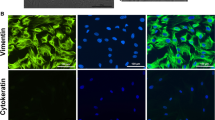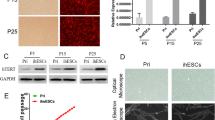Abstract
Overexpression of human telomerase reverse transcriptase (hTERT) has facilitated establishing in vitro model systems for biological research. The plasmid containing hTERT gene was stably transfected into ULTR cells, a retroviral transformed human uterine leiomyomatous smooth-muscle cell line. Cells that express hTERT, termed as ULTR-hT, shared the morphological characteristics of the parental proliferative ULTR cells. They expressed a set of smooth-muscle-specific genes and had increased proliferation rate and prolonged lifespan. Quantitative real-time polymerase chain reaction (PCR) analysis revealed a correlation of proliferation rates of ULTR-hT clonal cells with the level of hTERT expression. ULTR-hT cells also preserved expression of estrogen, progesterone, and oxytocin receptor genes, confirming a myometrial phenotype. Expression of angiotensin II receptors and nicotinamide adenine dinucleotide phosphate (NADPH) oxidase isoforms were also preserved. Our finding suggests that ULTR-hT cells can be a useful in vitro model for studying human myometrium differentiation both in pregnancy and pathological growth.
Similar content being viewed by others
References
Perez-Reyes N, Halbert CL, Smith PP, Benditt EP, McDougall JK. Immortalization of primary human smooth muscle cells. Proc Natl Acad Sci USA. 1992;89(4):1224–1228.
Zakian VA. Telomeres: beginning to understand the end. Science. 1995;270(5242):1601–1607.
Blackburn EH. Structure and function of telomeres. Nature. 1991;350(6319):569–573.
Allsopp RC, Vaziri H, Patterson C, et al. Telomere length predicts replicative capacity of human fibroblasts. Proc Natl Acad Sci USA. 1992;89(21):10114–10118.
Harley CB, Futcher AB, Greider CW. Telomeres shorten during ageing of human fibroblasts. Nature. 1990;345(6274): 458–460.
Feng J, Funk WD, Wang SS, et al. The RNA component of human telomerase. Science. 1995;269(5228):1236–1241.
Harrington L, Zhou W, McPhail T, et al. Human telomerase contains evolutionarily conserved catalytic and structural sub-units. Genes Dev. 1997;11(23):3109–3115.
Ulaner GA, Giudice LC. Developmental regulation of telomerase activity in human fetal tissues during gestation. Mol Hum Reprod. 1997;3(9):769–773.
Wright WE, Piatyszek MA, Rainey WE, Byrd W, Shay JW. Telomerase activity in human germline and embryonic tissues and cells. Dev Genet. 1996;18(2):173–179.
Counter CM, Hirte HW, Bacchetti S, Harley CB. Telomerase activity in human ovarian carcinoma. Proc Natl Acad Sci USA. 1994;91(8):2900–2904.
Kim NW, Piatyszek MA, Prowse KR, et al. Specific association of human telomerase activity with immortal cells and cancer. Science. 1994;266(5193):2011–2015.
Hooijberg E, Ruizendaal JJ, Snijders PJ, Kueter EW, Walboomers JM, Spits H. Immortalization of human CD8+ T cell clones by ectopic expression of telomerase reverse transcriptase. J Immunol. 2000;165(8):4239–4245.
Lee KM, Nguyen C, Ulrich AB, Pour PM, Ouellette MM. Immortalization with telomerase of the Nestin-positive cells of the human pancreas. Biochem Biophys Res Commun. 2003;301(4):1038–1044.
Puttmann S, Senner V, Braune S, et al. Establishment of a benign meningioma cell line by hTERT-mediated immortalization. Lab Invest. 2005;85(9):1163–1171.
Lewis CM, Herbert BS, Bu D, et al. Telomerase immortalization of human mammary epithelial cells derived from a BRCA2 mutation carrier. Breast Cancer Res Treat. 2006;99(1):103–115.
Meyerson M, Counter CM, Eaton EN, et al. hEST2, the putative human telomerase catalytic subunit gene, is upregulated in tumor cells and during immortalization. Cell. 1997;90(4):785–795.
Rodriguez LV, Alfonso Z, Zhang R, Leung J, Wu B, Ignarro LJ. Clonogenic multipotent stem cells in human adipose tissue differentiate into functional smooth muscle cells. Proc Natl Acad Sci USA. 2006;103(32):12167–12172.
Isenmann S, Cakouros D, Zannettino A, Shi S, Gronthos S. hTERT transcription is repressed by Cbfa1 in human mesenchymal stem cell populations. J Bone Miner Res. 2007;22(6): 897–906.
Hong SH, Nah HY, Lee YJ, et al. Expression of estrogen receptor-alpha and -beta, glucocorticoid receptor, and progesterone receptor genes in human embryonic stem cells and embryoid bodies. Mol Cells. 2004;18(3):320–325.
Nakamoto T, Yasuda K, Yasuhara M, et al. Cigarette smoke extract enhances oxytocin-induced rhythmic contractions of rat and human preterm myometrium. Reproduction. 2006;132(2): 343–353.
Cui X-L, Brockman D, Campos B, Myatt L. Expression of NADPH oxidase isoform 1 (Nox1) in human placenta: involvement in preeclampsia. Placenta. 2006;27(4–5):422–431.
Willey JC, Broussoud A, Sleemi A, Bennett WP, Cerutti P, Harris CC. Immortalization of normal human bronchial epithelial cells by human papillomaviruses 16 or 18. Cancer Res. 1991;51(19):5370–5377.
Bryan TM, Reddel RR. SV40-induced immortalization of human cells. Crit Rev Oncog. 1994;5(4):331–357.
Counter CM, Avilion AA, LeFeuvre CE, et al. Telomere shortening associated with chromosome instability is arrested in immortal cells which express telomerase activity. EMBO J. 1992;11(5):1921–1929.
Counter CM, Botelho FM, Wang P, Harley CB, Bacchetti S. Stabilization of short telomeres and telomerase activity accompany immortalization of Epstein-Barr virus-transformed human B lymphocytes. J Virol. 1994;68(5):3410–3414.
Yang J, Chang E, Cherry AM, et al. Human endothelial cell life extension by telomerase expression. J Biol Chem. 1999;274(37):26141–26148.
Rufer N, Migliaccio M, Antonchuk J, Humphries RK, Roosnek E, Lansdorp PM. Transfer of the human telomerase reverse transcriptase (TERT) gene into T lymphocytes results in extension of replicative potential. Blood. 2001;98(3):597–603.
Condon J, Yin S, Mayhew B, et al. Telomerase immortalization of human myometrial cells. Biol Reprod. 2002;67(2): 506–514.
Carney SA, Tahara H, Swartz CD, et al. Immortalization of human uterine leiomyoma and myometrial cell lines after induction of telomerase activity: molecular and phenotypic characteristics. Lab Invest. 2002;82(6):719–728.
Matsumura T, Takesue M, Westerman KA, et al. Establishment of an immortalized human-liver endothelial cell line with SV40T and hTERT. Transplantation. 2004;77(9):1357–1365.
Kudo Y, Hiraoka M, Kitagawa S, et al. Establishment of human cementifying fibroma cell lines by transfection with temperature-sensitive simian virus-40 T-antigen gene and hTERT gene. Bone. 2002;30(5):712–717.
Catherino W, Salama A, Potlog-Nahari C, Leppert P, Tsibris J, Segars J. Gene expression studies in leiomyomata: new directions for research. Semin Reprod Med. 2004;22(2): 83–90.
Shynlova O, Tsui P, Jaffer S, Lye SJ. Integration of endocrine and mechanical signals in the regulation of myometrial functions during pregnancy and labour. Eur J Obstet Gynecol Reprod Biol. 2009;144(suppl 1):S2–S10.
Watanabe K, Ogura G, Suzuki T. Leiomyoblastoma of the uterus: an immunohistochemical and electron microscopic study of distinctive tumours with immature smooth muscle cell differentiation mimicking fetal uterine myocytes. Histopathology. 2003;42(4):379–386.
White SL, Zhou MY, Low RB, Periasamy M. Myosin heavy chain isoform expression in rat smooth muscle development. Am J Physiol. 1998;275(2 pt 1):C581–C589.
Cavaille F, Fournier T, Dallot E, Dhellemes C, Ferre F. Myosin heavy chain isoform expression in human myometrium: presence of an embryonic nonmuscle isoform in leiomyomas and in cultured cells. Cell Motil Cytoskeleton. 1995;30(3): 183–193.
Blough ER, Rice KM, Desai DH, Wehner P, Wright GL. Aging alters mechanical and contractile properties of the Fisher 344/Nnia X Norway/Binia rat aorta. Biogerontology. 2007;8(3):303–313.
Birukov KG, Shirinsky VP, Stepanova OV, et al. Stretch affects phenotype and proliferation of vascular smooth muscle cells. Mol Cell Biochem. 1995;144(2):131–139.
Worth NF, Rolfe BE, Song J, Campbell GR. Vascular smooth muscle cell phenotypic modulation in culture is associated with reorganisation of contractile and cytoskeletal proteins. Cell Motil Cytoskeleton. 2001;49(3):130–145.
Garcia-Verdugo I, Tanfin Z, Dallot E, Leroy MJ, Breuiller-Fouche M. Surfactant protein A signaling pathways in human uterine smooth muscle cells. Biol Reprod. 2008;79(2):348–355.
Malik M, Catherino WH. Novel method to characterize primary cultures of leiomyoma and myometrium with the use of confirmatory biomarker gene arrays. Fertil Steril. 2007;87(5): 1166–1172.
Author information
Authors and Affiliations
Rights and permissions
About this article
Cite this article
Chang, B., Myatt, L. & Cui, XL. Loss of Proliferative Capacity in a Retroviral Immortalized Human Uterine Smooth Muscle Cell Line Derived From Leiomyoma Is Restored by hTERT Overexpression. Reprod. Sci. 16, 1062–1071 (2009). https://doi.org/10.1177/1933719109344773
Published:
Issue Date:
DOI: https://doi.org/10.1177/1933719109344773




